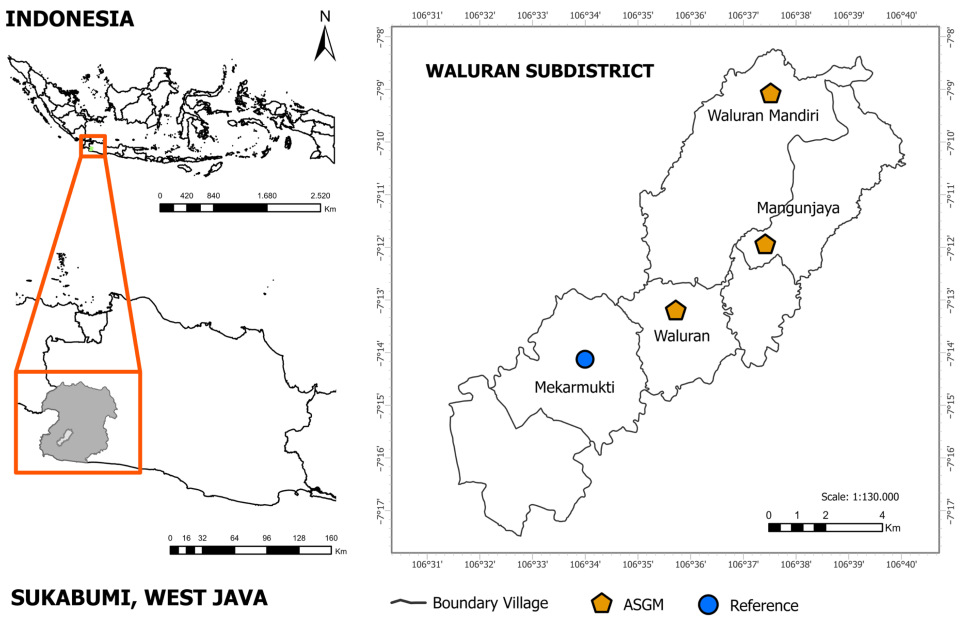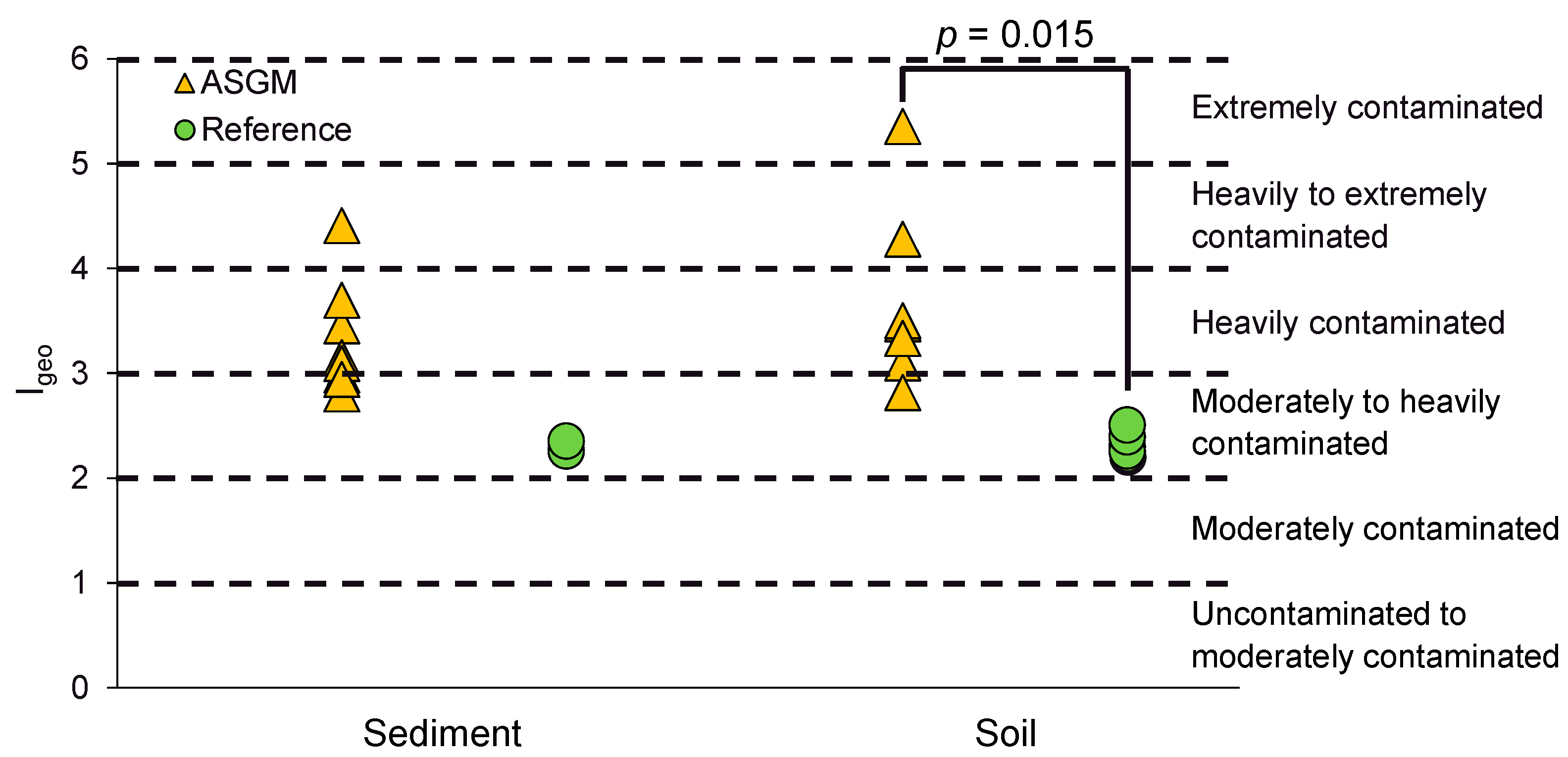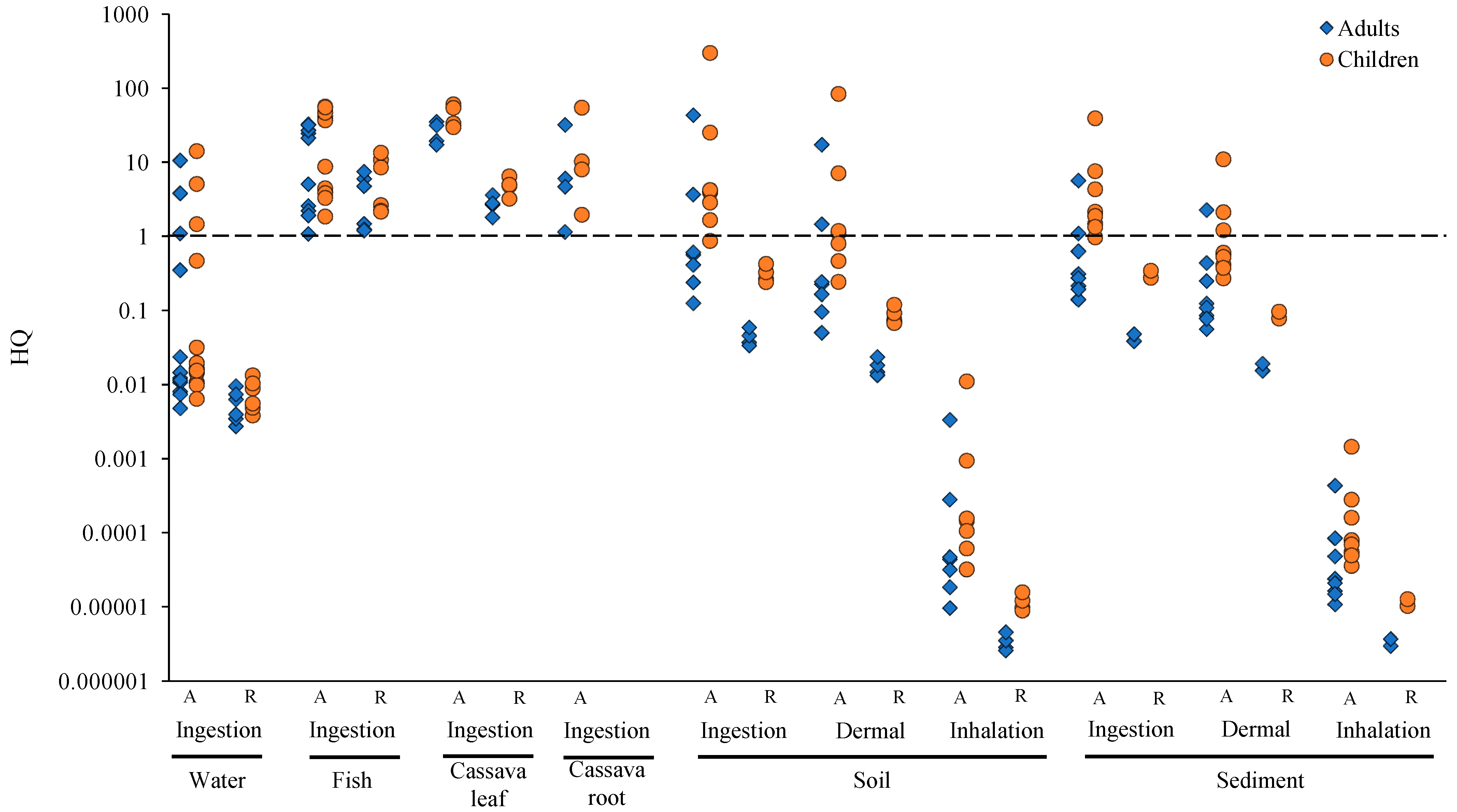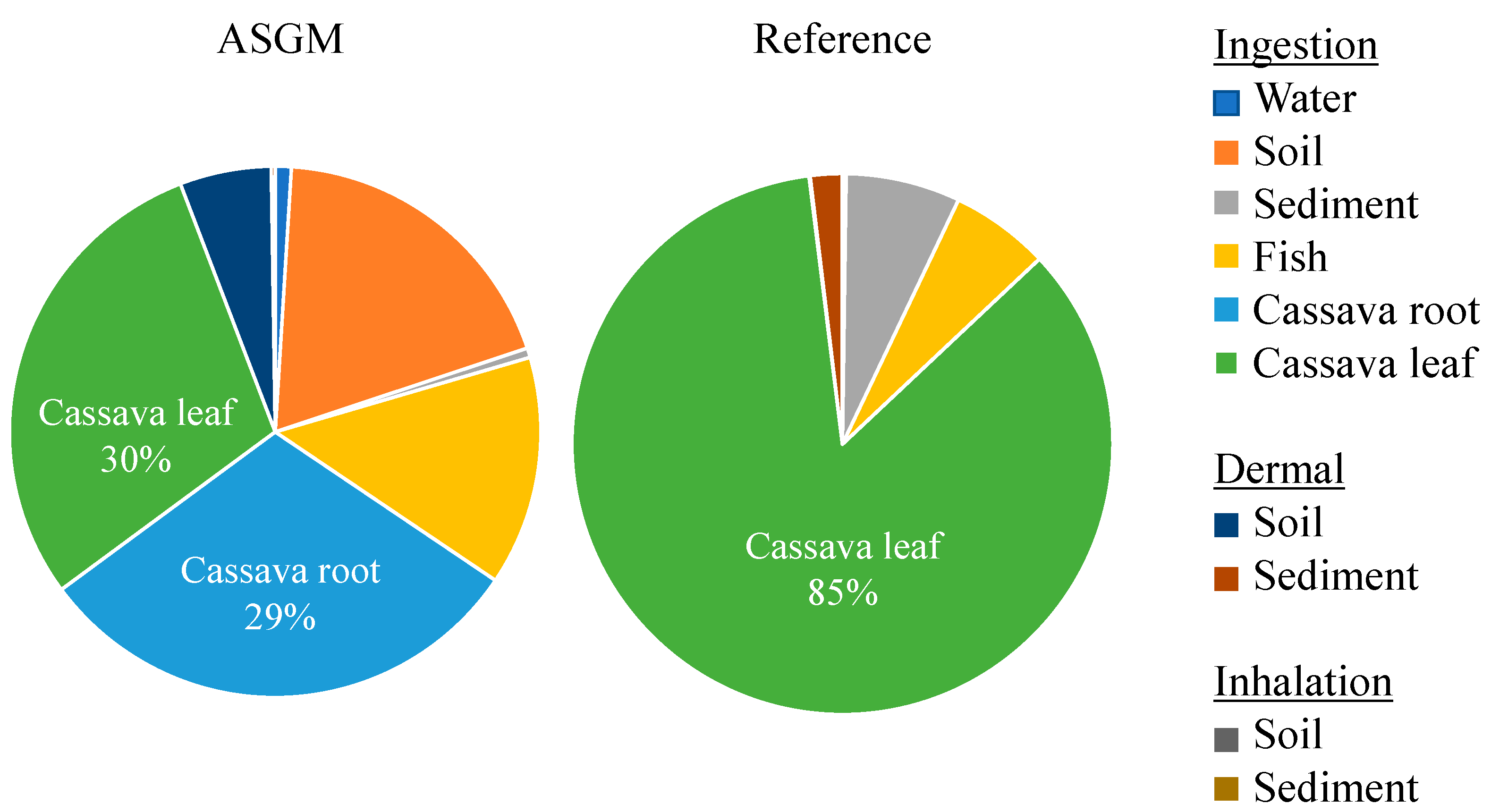Comprehensive Assessment of Mercury Contamination and Health Risks from Artisanal and Small-Scale Gold Mining (ASGM) in Sukabumi, Indonesia
Abstract
1. Introduction
2. Materials and Methods
2.1. Study Area
2.2. Sampling
2.3. Analytical Procedure
2.3.1. Sample Preparation
2.3.2. Analysis of Hg
2.3.3. Quality Assurance and Quality Control for Hg Analysis
2.4. Geo-Accumulation Index (Igeo) of Hg in Sediment and Soil
2.5. Contamination Factor of Hg in Soil
2.6. Bioconcentration Factor (BCF) of Hg in Fish
2.7. Bioaccumulation Factor (BAF) of Hg in Cassava Root
2.8. Health Risk Assessment
2.9. Statistical Analysis
3. Results and Discussion
3.1. Assessment of Hg Contamination
3.1.1. Water
3.1.2. Sediment
3.1.3. Soil
3.1.4. Fish
3.1.5. Cassava
3.2. Assessment of Hg Accumulation
3.2.1. Bioconcentration Factor (BCF) in Fish
3.2.2. Bioaccumulation Factor (BAF) in Cassava Root
3.3. Health Risk Assessment
3.4. Limitations of Study
3.5. Result-Based Recommendations
4. Conclusions
Supplementary Materials
Author Contributions
Funding
Institutional Review Board Statement
Informed Consent Statement
Data Availability Statement
Acknowledgments
Conflicts of Interest
References
- Arrighi, S.; Franceschini, F.; Petrini, R.; Fornasaro, S.; Ghezzi, L. The Legacy of Hg Contamination in a Past Mining Area (Tuscany, Italy): Hg Speciation and Health Risk Assessment. Toxics 2024, 12, 436. [Google Scholar] [CrossRef] [PubMed]
- United Nations Environment Programme (UNEP). Global Mercury Assessment 2018; UN Environment Programme, Chemicals and Health Branch: Geneva, Switzerland, 2019; Available online: https://www.unep.org/resources/publication/global-mercury-assessment-2018 (accessed on 8 September 2024)ISBN 978-92-807-3744-8.
- NEXUS3 Foundation. Towards Minamata COP-6: The State of Small-Scale Gold Mining (ASGM) in Indonesia; NEXUS3 Foundation: Bali, Indonesia, 2025; Available online: https://www.nexus3foundation.org/wp-content/uploads/2025/05/ENG-Indonesia-ASGM-National-Status-Report_compressed.pdf (accessed on 8 September 2024).
- GOLD-ISMIA. Annual Report 2020. 2020. Available online: https://www.goldismia.org/sites/default/files/2021-06/Annual%20Report%202020-8.pdf (accessed on 8 September 2024).
- Metaragakusuma, A.P.; Sakakibara, M.; Arifin, Y.I.; Pateda, S.M.; Jahja, M. Rural Knowledge Transformation in Terms of Mercury Used in Artisanal Small-Scale Gold Mining (ASGM)—A Case Study in Gorontalo, Indonesia. Int. J. Environ. Res. Public Health 2023, 20, 6640. [Google Scholar] [CrossRef]
- Radar Sukabumi. Penambang Illegal Rusak Lahan Perhutani. Radar Sukabumi, 2 August 2023. Available online: https://radarsukabumi.com/berita-utama/penambang-illegal-rusak-lahan-perhutani/ (accessed on 8 September 2024).
- Isa, I.G.T.; Setiawan, I.R.; Jhoansyah, D. The Potential of “Keripik Enye” Industry in Improving Local Welfare: A Case Study from Waluran Village. J. Masy. Mandiri 2019, 3, 29–40. [Google Scholar]
- Badan Pusat Statistik (BPS) Sukabumi. Luas Panen, Produktivitas dan Produksi Ubi Kayu Menurut Kecamatan di Kabupaten Sukabumi. 2023. Available online: https://sukabumikab.bps.go.id (accessed on 8 September 2024).
- Saragih, G.S.; Tapriziah, E.R.; Syofyan, Y.; Masitoh, S.; Pandiangan, Y.S.H.; Andriantoro, A. Mercury Contamination in Selected Edible Plants and Soil from Artisanal and Small-Scale Gold Mining in Sukabumi Regency, Indonesia. Makara J. Sci. 2021, 25, 222–228. [Google Scholar] [CrossRef]
- Harianja, A.H.; Saragih, G.S.; Fauzi, R.; Hidayat, M.Y.; Syofyan, Y.; Tapriziah, E.R.; Kartiningsih, S.E. Mercury Exposure in Artisanal and Small-Scale Gold Mining Communities in Sukabumi, Indonesia. J. Health Pollut. 2020, 10, 201209. [Google Scholar] [CrossRef]
- Agustiani, T.; Sulistia, S.; Sudaryanto, A.; Kurniawan, B.; Poku, P.A.; Elwaleed, A.; Kobayashi, J.; Ishibashi, Y.; Anan, Y.; Agusa, T. Mercury Contamination and Human Health Risk by Artisanal Small-Scale Gold Mining (ASGM) Activity in Gunung Pongkor, West Java, Indonesia. Earth 2025, 6, 67. [Google Scholar] [CrossRef]
- Central Bureau of Statistics of Sukabumi Regency. Waluran Subdistrict in Figures 2023; BPS Sukabumi: Sukabumi, Indonesia, 2023.
- Sukabumi Public Works and Spatial Planning Office. Topography and Landslide Risk Zoning Report for Southern Sukabumi; Sukabumi Government: Sukabumi, Indonesia, 2021.
- Meteorology, Climatology, and Geophysics Agency (BMKG). Annual Rainfall Statistics for Sukabumi Region; BMKG West Java Office: Bandung, Indonesia, 2022.
- Ministry of Home Affairs (Indonesia). Administrative Village Database of Sukabumi Regency; Directorate General of Population and Civil Registration: Jakarta, Indonesia, 2024.
- Khansa, F.R.; Hardiyono, A.; Sunarie, C.Y. Geologi Daerah Waluranmandiri dan Sekitarnya Kecamatan Waluran, Kabupaten Sukabumi, Provinsi Jawa Barat. Padjadjaran Geosci. J. 2024, 8, 1812–1820. [Google Scholar] [CrossRef]
- BMKG (Meteorology, Climatology, and Geophysics Agency of Indonesia). Online Data—Directorate of Data and Computation. Available online: https://dataonline.bmkg.go.id/dataonline-home (accessed on 20 August 2025).
- Badan Pusat Statistic (BPS), Sukabumi Regency. Sukabumi Regency in Figures 2024; BPS: Sukabumi, Indonesia, 2024. Available online: https://sukabumikab.bps.go.id/id/publication/2024/02/28/a7468802d2fddb1a70fda907/kabupaten-sukabumi-dalam-angka-2024.html (accessed on 20 August 2025).
- U.S. Environmental Protection Agency. Method 245.1: Determination of Mercury in Water by Cold Vapor Atomic Absorption Spectrometry (Revision 3.0); U.S. EPA: Cincinnati, OH, USA, 1994.
- Müller, G. Index of Geoaccumulation in Sediments of the Rhine River. GeoJournal 1969, 2, 108–118. [Google Scholar]
- Heumasse, H.; Omar, S.B.A.; Demmallino, E.B. Mercury (Hg) Contamination on Water, Sediment and Macrozoobenthos in Waelata River, Wamsait Village Waelata Sub-District, Buru District, Maluku Province. J. Phys. Conf. Ser. 2019, 1341, 092019. [Google Scholar] [CrossRef]
- Sudarningsih, S.; Fahruddin, F.; Lailiyanto, M.; Noer, A.A.; Husain, S.; Siregar, S.S.; Wahyono, S.C.; Ridwan, I. Assessment of Soil Contamination by Heavy Metals: A Case of Vegetable Production Center in Banjarbaru Region, Indonesia. Pol. J. Environ. Stud. 2022, 32, 249–257. [Google Scholar] [CrossRef] [PubMed]
- Hakanson, L. An Ecological Risk Index for Aquatic Pollution Control: A Sedimentological Approach. Water Res. 1980, 14, 975–1001. [Google Scholar] [CrossRef]
- OECD. Test No. 305: Bioaccumulation in Fish: Aqueous and Dietary Exposure; OECD Guidelines for the Testing of Chemicals, Section 3; OECD Publishing: Paris, France, 2012. [Google Scholar] [CrossRef]
- LaGrega, M.D.; Buckingham, P.L.; Evans, J.C. Hazardous Waste Management, 2nd ed.; McGraw-Hill: New York, NY, USA, 2001. [Google Scholar]
- Udiba, U.U.; Udofia, U.U.; Akpan, E.R.; Antai, E.E. Assessment of Lead (Pb) Uptake and Hazard Potentials of the Cassava Plant (Manihot esculentus cranz), Dareta Village, Zamfara, Nigeria. Int. Res. J. Public Environ. Health 2019, 6, 115–126. [Google Scholar]
- U.S. Environmental Protection Agency. Exposure Factors Handbook: 2011 Edition; National Center for Environmental Assessment: Washington, DC, USA, 2011. Available online: https://assessments.epa.gov/risk/document/&deid=236252 (accessed on 8 September 2024).
- González-Fernández, B.; Menéndez-Casares, E.; Meléndez-Asensio, M.; Fernández-Menéndez, S.; Ramos-Muñiz, F.; Cruz-Hernández, P.; González-Quirós, A. Sources of Mercury in Groundwater and Soils of West Gijón (Asturias, NW Spain). Sci. Total Environ. 2014, 481, 217–231. [Google Scholar] [CrossRef] [PubMed]
- Aleku, D.L.; Lazareva, O.; Pichler, T. Mercury in Groundwater–Source, Transport and Remediation. Appl. Geochem. 2024, 170, 106060. [Google Scholar] [CrossRef]
- Indonesia Minister of Environment and Forestry (IMEF). Minister of Environment and Forestry Regulation No. 6 of 2021 Concerning Procedures and Requirements for Managing Hazardous and Toxic Waste; Department of Environmental Affairs of Indonesia: Jakarta, Indonesia, 2021. Available online: https://jdih.menlhk.go.id/new/uploads/files/2021pmlhk006_menlhk_06082021104752.pdf (accessed on 8 September 2024).
- Indonesia Minister of Environment and Forestry (IMEF). Minister of Environment Regulation No. 5 of 2014 Concerning Wastewater Quality Standards; Department of Environmental Affairs of Indonesia: Jakarta, Indonesia, 2014. Available online: https://jdih.menlhk.go.id/new2/home/open_indonesia_file/MLH%20P.5.pdf (accessed on 8 September 2024).
- Australian and New Zealand Environment and Conservation Council (ANZECC). Australian and New Zealand Guidelines for Fresh and Marine Water Quality; ANZECC & Agriculture and Resource Management Council of Australia and New Zealand (ARMCANZ): Canberra, Australia, 2000.
- Nugraha, W.C.; Ishibashi, Y.; Arizono, K. Assessment of Heavy Metal Distribution and Contamination in the Sediment of the Ciujung Watershed, Banten Province, Indonesia. J. Mater. Cycles Waste Manag. 2023, 25, 2619–2631. [Google Scholar] [CrossRef]
- Harvey, J.W.; Krupa, S.L.; Gefvert, C.; Mooney, R.H.; Choi, J.; King, S.A.; Giddings, J.B. Interactions Between Surface Water and Ground Water and Effects on Mercury Transport in the North-Central Everglades; Water-Resources Investigations Report 02-4050; South Florida Water Management District: Reston, VA, USA, 2002.
- Driscoll, C.T.; Han, Y.J.; Chen, C.Y.; Evers, D.C.; Lambert, K.F.; Holsen, T.M.; Kamman, N.C.; Munson, R.K. Mercury Contamination in Forest and Freshwater Ecosystems in the Northeastern United States. BioScience 2007, 57, 17–28. [Google Scholar] [CrossRef]
- Soe, P.S.; Kyaw, W.T.; Arizono, K.; Ishibashi, Y.; Agusa, T. Mercury Pollution from Artisanal and Small-Scale Gold Mining in Myanmar and Other Southeast Asian Countries. Int. J. Environ. Res. Public Health 2022, 19, 6290. [Google Scholar] [CrossRef]
- Indonesia Food and Drug Administration (IFDA). Indonesia Food and Drug Administration Regulation No. 9 of 2021 Concerning Requirements for Heavy Metal Contaminants in Processed Food; IFDA: Jakarta, Indonesia, 2022. Available online: https://standarpangan.pom.go.id/dokumen/peraturan/202x/logam_2022.pdf (accessed on 8 September 2024).
- Nakoe, M.R.; Ardian, Y.; Ruhardi, A.; Dwinugroho, F.; Yudhastuti, R.; Sulistyorini, L.; Azizah, R.; Indriani, D. Risk Assessment Exposure of Mercury (Hg) at People Who Consuming Nila Fish (Oreochromis niloticus) from Limboto Lake of Gorontalo Province. Res. J. Pharm. Biol. Chem. Sci. 2014, 5, 1420–1427. [Google Scholar]
- Maddusa, S.S.; Asrifuddin, A.; Mantjoro, E.M. Public Health Risk Analysis Due to Consuming Tilapia (Oreochromis niloticus) Containing Heavy Metals in Bakan Village, Lolayan District, Bolaang Mongondow Regency. Int. J. Community Med. Public Health 2022, 10, 45. [Google Scholar] [CrossRef]
- Mulyani, I.; Yamin, M.; Khairuddin, K. Analysis of Mercury (Hg) Content in Tilapia Fish (Oreochromis mossambicus) from Rawa Taliwang Lake to Enrich the Course Materials on Ecotoxicology. J. Penelit. Pendidik. IPA 2023, 9, 4679–4684. [Google Scholar] [CrossRef]
- Boohene, M.; Poku, P.A.; Sulistia, S.; Brown, C.; Morokuma, E.; Agusa, T.; Arizono, K.; Anan, Y.; Ishibashi, Y. Human Health Risk Assessments of Mercury from the Ingestion of Edible Fishes from Birim River, Ghana. Available online: http://www.fundtoxicolsci.org/index_e.html (accessed on 8 September 2024).
- Kola, S.; Kanja, L.W.; Mbaria, J.M.; Maina, J.G.; Okumu, M.O. Levels of Mercury in Nile Tilapia (Oreochromis niloticus), Water, and Sediment in the Migori Gold Mining Belt, Kenya, and the Potential Ramifications to Human Health. F1000Research 2019, 8, 1244. [Google Scholar] [CrossRef]
- Ullrich, S.M.; Tanton, T.W.; Abdrashitova, S.A. Mercury in the Aquatic Environment: A Review of Factors Affecting Methylation. Crit. Rev. Environ. Sci. Technol. 2001, 31, 241–293. [Google Scholar] [CrossRef]
- Gilmour, C.C.; Podar, M.; Bullock, A.L.; Graham, A.M.; Brown, S.D.; Somenahally, A.C.; Johs, A.; Hurt, R.A.; Bailey, K.L.; Elias, D.A. Mercury methylation by novel microorganisms from new environments. Environ. Sci. Technol. 2013, 47, 11810–11820. [Google Scholar] [CrossRef] [PubMed]
- Hurley, J.P.; Krabbenhoft, D.P.; Cleckner, B.L.; Olson, M.L.; Aiken, G.R.; Rawlik, P.S., Jr. System controls on the aqueous distribution of mercury in the northern Wisconsin lakes. Environ. Sci. Technol. 1998, 32, 1424–1432. [Google Scholar] [CrossRef]
- Wang, F.; Outridge, P.M.; Feng, X.; Meng, B.; Heimbürger-Boavida, L.E.; Mason, R.P. How closely do mercury trends in fish and other aquatic wildlife track those in the atmosphere? Sci. Total Environ. 2014, 466–467, 879–887. [Google Scholar]
- Cabana, G.; Rasmussen, J.B. Modeling Food Chain Structure and Contaminant Bioaccumulation Using Stable Nitrogen Isotopes. Nature 1994, 372, 255–257. [Google Scholar] [CrossRef]
- Nyanza, E.C.; Dewey, D.; Thomas, D.S.K.; Davey, M.; Ngallaba, S.E. Spatial Distribution of Mercury and Arsenic Levels in Water, Soil and Cassava Plants in a Community with Long History of Gold Mining in Tanzania. Bull. Environ. Contam. Toxicol. 2014, 93, 716–721. [Google Scholar] [CrossRef]
- Adjorlolo-Gasokpoh, A.; Golow, A.A.; Kambo-Dorsa, J. Mercury in the Surface Soil and Cassava, Manihot esculenta (Flesh, Leaves and Peel) Near Goldmines at Bogoso and Prestea, Ghana. Bull. Environ. Contam. Toxicol. 2012, 89, 1106–1110. [Google Scholar] [CrossRef]
- Kono, Y.; Rahajoe, J.S.; Hidayati, N.; Kodamatani, H.; Tomiyasu, T. Using native epiphytic ferns to estimate the atmospheric mercury levels in a small-scale gold mining area of West Java, Indonesia. Chemosphere 2012, 89, 241–248. [Google Scholar] [CrossRef]
- Zhang, H.; Feng, X.; Larssen, T.; Qiu, G.; Vogt, R.D. In Inland China, Rice, Rather Than Fish, Is the Major Pathway for Methylmercury Exposure. Environ. Health Perspect. 2010, 118, 1183–1188. [Google Scholar] [CrossRef] [PubMed]
- Xu, D.; Shen, Z.; Dou, C.; Dou, Z.; Li, Y.; Gao, Y.; Sun, Q. Effects of Soil Properties on Heavy Metal Bioavailability and Accumulation in Crop Grains under Different Farmland Use Patterns. Sci. Rep. 2022, 12, 9211. [Google Scholar] [CrossRef]
- Yang, Y.; Yanai, R.D.; Driscoll, C.T.; Montesdeoca, M.; Smith, K.T. Concentrations and content of mercury in bark, wood, and leaves in hardwoods and conifers in four forested sites in the northeastern USA. PLoS ONE 2018, 13, e0196293. [Google Scholar] [CrossRef] [PubMed]
- Marrugo-Negrete, J.; Marrugo-Madrid, S.; Pinedo-Hernández, J.; Durango-Hernández, J.; Díez, S. Screening of Native Plant Species for Phytoremediation Potential at a Hg-Contaminated Mining Site. Sci. Total Environ. 2016, 542, 809–816. [Google Scholar] [CrossRef]
- Ramlan; Basir-Cyio, M.; Napitupulu, M.; Inoue, T.; Anshary, A.; Mahfudz; Isrun; Rusydi, M.; Golar; Sulbadana; et al. Pollution and Contamination Level of Cu, Cd, and Hg Heavy Metals in Soil and Food Crop. Int. J. Environ. Sci. Technol. 2022, 19, 1153–1164. [Google Scholar] [CrossRef]
- Addai-Arhin, S.; Novirsa, R.; Jeong, H.H.; Phan, Q.D.; Hirota, N.; Ishibashi, Y.; Shiratsuchi, H.; Arizono, K. Potential Human Health Risk of Mercury-contaminated cassavas—Preleminary studies. Fundam. Toxicol. Sci. 2022, 9, 61–69. [Google Scholar] [CrossRef]
- Ssenku, J.E.; Naziriwo, B.; Kutesakwe, J.; Mustafa, A.S.; Kayeera, D.; Tebandeke, E. Mercury Accumulation in Food Crops and Phytoremediation Potential of Wild Plants Thriving in Artisanal and Small-Scale Gold Mining Areas in Uganda. Pollutants 2023, 3, 181–196. [Google Scholar] [CrossRef]
- Basri; Sakakibara, M.; Sera, K. Mercury in Soil and Forage Plants from Artisanal and Small-Scale Gold Mining in the Bombana Area, Indonesia. Toxics 2020, 8, 15. [Google Scholar] [CrossRef] [PubMed]
- Arrazy, S.; Addai-Arhin, S.; Jeong, H.; Novirsa, R.; Wispriyono, B.; Agusa, T.; Ishibashi, Y.; Kobayashi, J. Spatial Distribution and Human Health Risks of Mercury in the Gold Mining Area of Mandailing Natal District, Indonesia. Environ. Monit. Contam. Res. 2023, 3, 33–42. [Google Scholar] [CrossRef]
- Sanga, T.R.; Maseka, K.K.; Ponraj, M.; Tungaraza, C.; Mng’ong’o, M.E.; Mwakalapa, E.B. Accumulation and Distribution of Mercury in Agricultural Soils, Food Crops and Associated Health Risks: A Case Study of Shenda Gold Mine-Geita Tanzania. Environ. Chall. 2023, 11, 100697. [Google Scholar] [CrossRef]
- Komala, P.S.; Azhari, R.M.; Hapsari, F.Y.; Edwin, T.; Ihsan, T.; Zulkarnaini; Harefa, M. Comparison of Bioconcentration Factor of Heavy Metals Between Endemic Fish and Aquacultured Fish in Maninjau Lake, West Sumatra, Indonesia. Biodiversitas 2022, 23, 4026–4032. [Google Scholar] [CrossRef]
- Triswanto, B.; Wibowo, M.A.; Ardiningsih, P. A Study of Mercury Pollution in Water, Sediment, and Lais (Kryptopterus) Fish in the Melawi Watershed. J. Trop. Life Sci. 2020, 10, 207–213. [Google Scholar] [CrossRef]
- Prilia, D.; Oginawati, K.; Ariesyady, H.D. Analysis of Mercury in Water and Sediment Distribution and Its Bioaccumulation Potential in Fish in the Small-Scale Gold Mining Area (Case Study: Ciberang River, Lebak, Banten). J. Water Sustain. 2013, 2, 107–116. [Google Scholar] [CrossRef]
- Tresnayaputri, C.I.A.; Lumban Batu, D.T.F.; Sulistiono. Kandungan Logam Berat (Hg, Cd, Pb, dan Cu) pada Ikan Baronang Siganus javus (Linnaeus, 1766) di Perairan Teluk Banten dan Sekitarnya. IPB University Repository. 2021. Available online: http://repository.ipb.ac.id/handle/123456789/107935 (accessed on 8 September 2024).
- Łuczyńska, J.; Paszczyk, B.; Łuczyński, M.J.; Kowalska-Góralska, M.; Nowosad, J.; Kucharczyk, D. Using Rutilus rutilus (L.) and Perca fluviatilis (L.) as Bioindicators of the Environmental Condition and Human Health: Lake Łańskie, Poland. Int. J. Environ. Res. Public Health 2020, 17, 7595. [Google Scholar] [CrossRef]
- Al-Sisi, M.; Elhawat, N.; Alshaal, T.; Eissa, F. Assessment of Trace Element Occurrence in Nile Tilapia from the Rosetta Branch of the River Nile, Egypt: Implications for Human Health Risk via Lifetime Consumption. Ecotoxicol. Environ. Saf. 2024, 285, 117079. [Google Scholar] [CrossRef]
- Cai, S.; Zeng, B.; Li, C. Potential Health Risk Assessment of Metals in the Muscle of Seven Wild Fish Species from the Wujiangdu Reservoir, China. Qual. Assur. Saf. Crops Foods 2023, 15, 73–83. [Google Scholar] [CrossRef]
- Hsu-Kim, H.; Kucharzyk, K.H.; Zhang, T.; Deshusses, M.A. Mechanisms Regulating Mercury Bioavailability for Methylating Microorganisms in the Aquatic Environment: A Critical Review. Environ. Sci. Technol. 2013, 47, 2441–2456. [Google Scholar] [CrossRef] [PubMed]
- Lavoie, R.A.; Jardine, T.D.; Chumchal, M.M.; Kidd, K.A.; Campbell, L.M. Biomagnification of Mercury in Aquatic Food Webs: A Worldwide Meta-Analysis. Environ. Sci. Technol. 2013, 47, 13385–13394. [Google Scholar] [CrossRef] [PubMed]
- Kidd, K.A.; Clayden, M.G.; Jardine, T.D. Bioaccumulation and Biomagnification of Mercury Through Food Webs. In Environmental Chemistry and Toxicology of Mercury; John Wiley & Sons, Inc.: Hoboken, NJ, USA, 2012; pp. 455–499. [Google Scholar] [CrossRef]
- Chen, C.Y.; Stemberger, R.S.; Kamman, N.C.; Mayes, B.M.; Folt, C.L. Patterns of Hg Bioaccumulation and Transfer in Aquatic Food Webs Across Multiple Reservoirs. Environ. Pollut. 2009, 157, 2435–2444. [Google Scholar] [CrossRef]
- Kambey, J.L.; Farrell, A.P.; Bendell-Young, L.I. Influence of Illegal Gold Mining on Mercury Levels in Fish of North Sulawesi’s Minahasa Peninsula, Indonesia. Environ. Pollut. 2001, 114, 299–302. [Google Scholar] [CrossRef]
- Castilhos, Z.C.; Rodrigues-Filho, S.; Rodrigues, A.P.; Villas-Bôas, R.C.; Siegel, S.; Veiga, M.M.; Beinhoff, C. Mercury Contamination in Fish from Gold Mining Areas in Indonesia and Human Health Risk Assessment. Sci. Total Environ. 2006, 368, 320–325. [Google Scholar] [CrossRef]
- Bose-O’Reilly, S.; McCarty, K.M.; Steckling, N.; Lettmeier, B. Mercury Exposure and Children’s Health. Curr. Probl. Pediatr. Adolesc. Health Care 2010, 40, 186–215. [Google Scholar] [CrossRef] [PubMed]
- Li, P.; Feng, X.; Wang, S.; Feng, X.; Qiu, G. Mercury Exposure in Rice-Based Diets in SW China. Environ. Pollut. 2009, 157, 326–330. [Google Scholar] [CrossRef]
- Wang, Y.; Chen, C.; Chen, Y.; Lu, X.; Feng, X.; Qiu, G. Bioaccumulation and Transformation of Mercury in Crops from Mining-Impacted Areas. Sci. Total Environ. 2020, 712, 135575. [Google Scholar] [CrossRef]





| Sample | ASGM | Reference | Statistical Analysis | p |
|---|---|---|---|---|
| Water (µg/L) | ||||
| Groundwater | T = 1.75 | 0.167 | ||
| Mean ± SD | 0.093 ± 0.064 | 0.035 ± 0.015 | ||
| Range | 0.037–0.183 | <0.026–0.051 | ||
| Median | 0.076 | 0.032 | ||
| n | 4 | 3 | ||
| Tailing water | ||||
| Mean ± SD | 30.6 ± 36.1 | NA | NA | NA |
| Range | 2.70–82.0 | NA | ||
| Median | 18.9 | NA | ||
| n | 4 | 0 | ||
| Pond water | ||||
| Mean ± SD | 0.094 ± 0.032 | 0.055 ± 0.025 | U = 7.00 | 0.300 |
| Range | 0.057–0.113 | 0.028–0.077 | ||
| Median | 0.113 | 0.060 | ||
| n | 3 | 3 | ||
| Sediment (mg/kg dw) | ||||
| River | ||||
| Mean ± SD | 35.3 | NA | NA | NA |
| Range | 21.9–48.7 | NA | ||
| Median | 35.3 | NA | ||
| n | 2 | 0 | ||
| Fish pond | ||||
| Mean ± SD | 35.4 ± 6.44 | 6.99 | NA | NA |
| Range | 30.2–42.6 | 6.24–7.74 | ||
| Median | 33.4 | 6.99 | ||
| n | 3 | 2 | ||
| Tailing | ||||
| Mean ± SD | 384 ± 434 | NA | NA | NA |
| Range | 97.8–883 | NA | ||
| Median | 171 | NA | ||
| n | 3 | 0 | ||
| Soil (mg/kg dw) | ||||
| Agriculture | T = 2.84 | 0.029 | ||
| Mean ± SD | 60.2 ± 37.3 | 7.10 ± 1.86 | ||
| Range | 19.6–95.0 | 5.44–9.59 | ||
| Median | 63.1 | 6.69 | ||
| n | 4 | 4 | ||
| Burning | NA | NA | ||
| Mean ± SD | 2470 ± 3730 | NA | ||
| Range | 64.4–9760 | NA | ||
| Median | 571 | NA | ||
| n | 3 | 0 | ||
| Fish (mg/kg dw) | T = 2.521 | 0.03 | ||
| Mean ± SD | 5.55 ± 5.00 | 1.35 ± 1.01 | ||
| Range | 0.411–12.8 | 0.413–2.70 | ||
| Median | 4.76 | 1.14 | ||
| n | 10 | 6 | ||
| Cassava (mg/kg dw) | ||||
| Cassava leaf | T = 4.647 | 0.002 | ||
| Mean ± SD | 17.4 ± 6.77 | 2.58 ± 3.54 | ||
| Range | 11.9–26.2 | 0.22–7.85 | ||
| Median | 15.7 | 1.12 | ||
| n | 4 | 4 | ||
| Cassava root | U = 16.0 | 0.021 | ||
| Mean ± SD | 1.57 ± 0.48 | <0.001 | ||
| Range | 1.03–2.19 | <0.001 | ||
| Median | 1.54 | <0.001 | ||
| n | 4 | 4 |
| Index | r | p |
|---|---|---|
| Fish-Length | 0.236 | 0.380 |
| Weight | 0.218 | 0.418 |
| Water | 0.322 | 0.223 |
| Sediment | 0.318 | 0.230 |
| Soil-Cassava root | 0.812 | 0.014 |
| Cassava leaf | 0.643 | 0.086 |
| Cassava root–Cassava leaf | 0.913 | 0.002 |
| Study Area | Species | Location | BCF | Reference |
|---|---|---|---|---|
| Waluran District, Sukabumi, West Java, Indonesia | Tilapia | ASGM area | 770–23,363 | This study |
| Reference area | 1683–22,464 | |||
| Gunung Pongkor, Bogor, West Java, Indonesia | Tilapia | ASGM area | 31–4279 | [11] |
| Tanjung Raya Sub-district, Agam District, West Sumatra Province, Indonesia | R. argyrotaenia | Dense settlement | 0.825 | [61] |
| Hydropower | 0.668 | |||
| Fish cage | 0.845 | |||
| Endemic fisheries | 0.679 | |||
| Tilapia | Dense settlement | 3.408 | ||
| Hydropower | 2.463 | |||
| Fish cage | 4.319 | |||
| Endemic fisheries | 1.584 | |||
| Melawi watershed, West Kalimantan, Indonesia | Kryp-topterus | ASGM area | [62] | |
| - Upper Lengkong Nyadom Village | 731–962 | |||
| - Lengkong Nyadom Village | 761–1126 | |||
| - Tanjung Pauh Village | 1225–2766 | |||
| - Downstream Tanjung Pauh Village | 1055–6067 | |||
| Ciberang River, Lebak, Banten, Indonesia | Barbonymusgonionotus | Upstream to downstream Ciberang River | 2328–4354 | [63] |
| Channa striata | 1561–1876 | |||
| Banten Bay, Banten, Indonesia | Streaked spinefoot | Power plant area | 5000 | [64] |
| Lake Lanskie, Ramuckie Forests, South of Olsztyn, Poland | Perch (Perca Fluviatilis L.) Roach (Rutilus Rutilus L.) | Not receiving point source pollution | 11,056 | [65] |
| River Nile, Egypt | Tilapia | Proximity of three drainage systems (El-Rahawy, Sabal, and Tala) | 15.5–87.2 | [66] |
| Wujiang River, Guizhou province, China | C. auratus | Wujiangdu Reservoir | 2152 | [67] |
| C. carpio | 1299 | |||
| H. leucisculus | 1949 | |||
| P. fulvidraco | 2111 | |||
| S. meriaionalis | 2274 | |||
| C. idellus | 1218 | |||
| P. pekinensis | 974 |
Disclaimer/Publisher’s Note: The statements, opinions and data contained in all publications are solely those of the individual author(s) and contributor(s) and not of MDPI and/or the editor(s). MDPI and/or the editor(s) disclaim responsibility for any injury to people or property resulting from any ideas, methods, instructions or products referred to in the content. |
© 2025 by the authors. Licensee MDPI, Basel, Switzerland. This article is an open access article distributed under the terms and conditions of the Creative Commons Attribution (CC BY) license (https://creativecommons.org/licenses/by/4.0/).
Share and Cite
Agustiani, T.; Sulistia, S.; Suciati, F.; Sudaryanto, A.; Amandita, F.Y.; Efadeswarni; Handika, R.; Poku, P.A.; Boohene, M.; Kobayashi, J.; et al. Comprehensive Assessment of Mercury Contamination and Health Risks from Artisanal and Small-Scale Gold Mining (ASGM) in Sukabumi, Indonesia. Earth 2025, 6, 110. https://doi.org/10.3390/earth6030110
Agustiani T, Sulistia S, Suciati F, Sudaryanto A, Amandita FY, Efadeswarni, Handika R, Poku PA, Boohene M, Kobayashi J, et al. Comprehensive Assessment of Mercury Contamination and Health Risks from Artisanal and Small-Scale Gold Mining (ASGM) in Sukabumi, Indonesia. Earth. 2025; 6(3):110. https://doi.org/10.3390/earth6030110
Chicago/Turabian StyleAgustiani, Tia, Susi Sulistia, Fuzi Suciati, Agus Sudaryanto, Fitri Yola Amandita, Efadeswarni, Rendi Handika, Patrick Adu Poku, Margaret Boohene, Jun Kobayashi, and et al. 2025. "Comprehensive Assessment of Mercury Contamination and Health Risks from Artisanal and Small-Scale Gold Mining (ASGM) in Sukabumi, Indonesia" Earth 6, no. 3: 110. https://doi.org/10.3390/earth6030110
APA StyleAgustiani, T., Sulistia, S., Suciati, F., Sudaryanto, A., Amandita, F. Y., Efadeswarni, Handika, R., Poku, P. A., Boohene, M., Kobayashi, J., Ishibashi, Y., Morrow, J. S., Anan, Y., & Agusa, T. (2025). Comprehensive Assessment of Mercury Contamination and Health Risks from Artisanal and Small-Scale Gold Mining (ASGM) in Sukabumi, Indonesia. Earth, 6(3), 110. https://doi.org/10.3390/earth6030110






